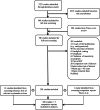Interventions for preventing falls and fall-related fractures in community-dwelling older adults: A systematic review and network meta-analysis
- PMID: 34318929
- PMCID: PMC8518387
- DOI: 10.1111/jgs.17375
Interventions for preventing falls and fall-related fractures in community-dwelling older adults: A systematic review and network meta-analysis
Abstract
Objective: To compare the effectiveness of single, multiple, and multifactorial interventions to prevent falls and fall-related fractures in community-dwelling older persons.
Methods: MEDLINE, Embase, and Cochrane Central Register of Controlled Trials were systematically searched for randomized controlled trials (RCTs) evaluating the effectiveness of fall prevention interventions in community-dwelling adults aged ≥65 years, from inception until February 27, 2019. Two large RCTs (published in 2020 after the search closed) were included in post hoc analyses. Pairwise meta-analysis and network meta-analysis (NMA) were conducted.
Results: NMA including 192 studies revealed that the following single interventions, compared with usual care, were associated with reductions in number of fallers: exercise (risk ratio [RR] 0.83; 95% confidence interval [CI] 0.77-0.89) and quality improvement strategies (e.g., patient education) (RR 0.90; 95% CI 0.83-0.98). Exercise as a single intervention was associated with a reduction in falls rate (RR 0.79; 95% CI 0.73-0.86). Common components of multiple interventions significantly associated with a reduction in number of fallers and falls rate were exercise, assistive technology, environmental assessment and modifications, quality improvement strategies, and basic falls risk assessment (e.g., medication review). Multifactorial interventions were associated with a reduction in falls rate (RR 0.87; 95% CI 0.80-0.95), but not with a reduction in number of fallers (RR 0.95; 95% CI 0.89-1.01). The following single interventions, compared with usual care, were associated with reductions in number of fall-related fractures: basic falls risk assessment (RR 0.60; 95% CI 0.39-0.94) and exercise (RR 0.62; 95% CI 0.42-0.90).
Conclusions: In keeping with Tricco et al. (2017), several single and multiple fall prevention interventions are associated with fewer falls. In addition to Tricco, we observe a benefit at the NMA-level of some single interventions on preventing fall-related fractures.
Keywords: community-dwelling; fall-related fractures; falls; older adults.
© 2021 The Authors. Journal of the American Geriatrics Society published by Wiley Periodicals LLC on behalf of The American Geriatrics Society.
Conflict of interest statement
Dr Tricco reports receiving a Tier 2 Canada Research Chair in Knowledge Synthesis grant. Dr Straus reports receiving a Tier 1 Canada Research Chair in Knowledge Translation grant. No other financial or personal conflicts were reported.
Figures
References
-
- National Institute for Health and Care Excell . Falls in older people: assessing risk and prevention. NICE Clin Guidel. Manchester: National Institute for Health and Care Excellence; 2013:1‐33 https://www.nice.org.uk/guidance/cg161/resources/falls-in-older-people-a.... Accessed November 4, 2019. - PubMed
-
- Tinetti M, Speechley M, Ginter S. Risk factors for falls among elderly persons living in the community. N Engl J Med. 1988;319:1701‐1707. - PubMed
-
- Campbell A, Borrie M, Spears G, Jackson S, Brown J, Fitzgerald J. Circumstances and consequences of falls experienced by a community population 70 years and over during a prospective study. Age Ageing. 1990;19:136‐141. - PubMed
-
- Deandrea S, Lucenteforte E, Bravi F, Foschi R, La Vecchia C, Negria E. Risk factors for falls in community‐dwelling older people a systematic review and meta‐analysis. Epidemiology. 2010;21(5):658‐668. - PubMed


